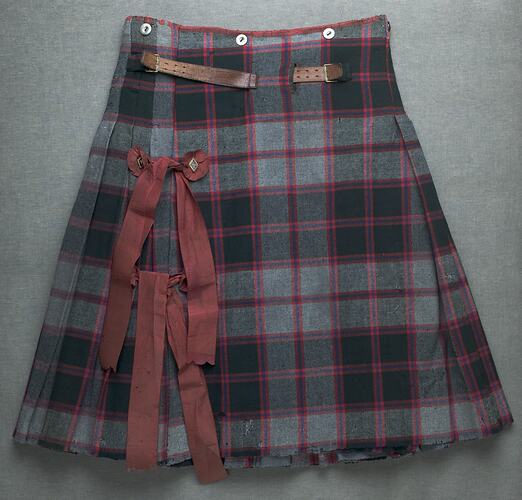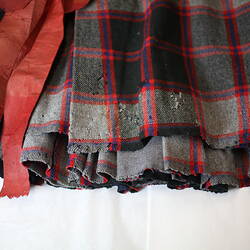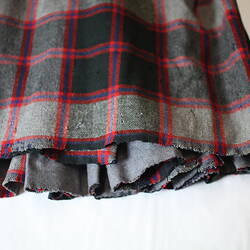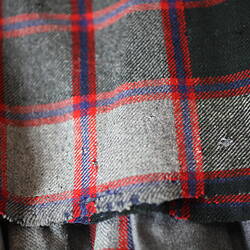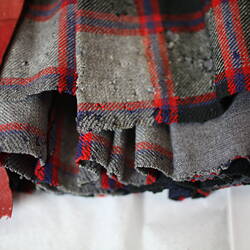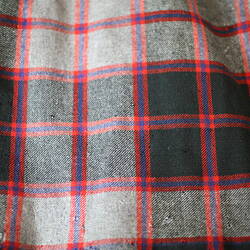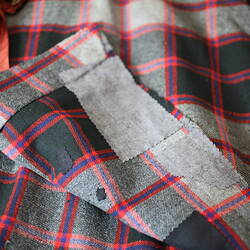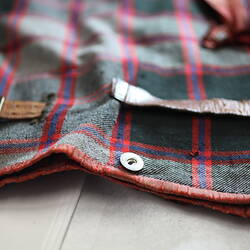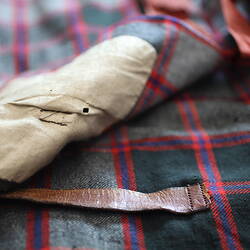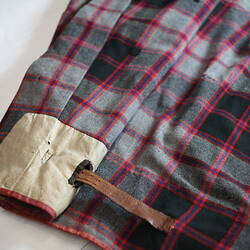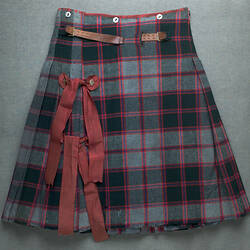Summary
Heavy wool kilt of MacPherson hunting tartan.
Part of a Scottish regalia kit that was brought to Australia by Dugald McPherson, who arrived in Victoria in 1840 aged 20. McPherson was a pioneer squatter who first settled at Ballan, northwest of Melbourne, and subsequently developed huge landholdings in northwestern Victoria, New South Wales and Queensland. A stalwart of the Scottish immigrant community, McPherson was chief of the Highland Society of Ballarat and an elder of the Presbyterian Church. With other wealthy pastoralists, he later helped form the Australian Club in William Street. His second son Arthur married Annie Fawkner, a daughter of John Fawkner. In 1861, William Wills, father of William John Wills of Burke & Wills fame, stayed briefly with Dugald during the agonizing wait for his missing son.
Physical Description
Pleated kilt of heavy wool tartan. Leather straps and buckles act as securing devices. Red silk trim around the waistline. Signs of significant wear, causing loss of fabric at the waistline. Insect damage has resulted in losses throughout.
Significance
According to Major Proctor of the Black Watch (Nov 2009, correspondence with John Macpherson), the Black Watch and the Argyll and Sutherland Highlanders are the only two highland regiments to wear rosettes on their kilts. The Black Watch have been wearing ribbons (rosettes) on their kilts since the mid-18th century when the 'great kilt' (12 yards long, all in one garment, kilt and plaid) was worn. The Sutherland Highlanders only started this tradition in the 19th century. While the origins of the ribbons are rather hazy, it is believed that coloured ribbons were used by the men when sleeping rough to tie the fabric together. In later times only the officers and sergeants continued this tradition.
More Information
-
Collection Names
-
Collecting Areas
Public Life & Institutions, Migration & Cultural Diversity, Clothing & Textiles
-
Acquisition Information
Donation from Miss Hope Macpherson - National Museum of Victoria, Nov 1962
-
Place & Date Made
Scotland, Great Britain, 1820-1830
Latest date based on the fact that the user left Scotland with the regalia in 1839, arriving in Victoria in January 1840. -
User
Dugald McPherson, Ballan, Victoria, Australia, 1840-1901
Dates of use based on date of user's immigration to Australia and date of death. -
Classification
-
Category
-
Discipline
-
Type of item
-
Overall Dimensions
64 cm (Length), 86 cm (Width), 1.3 kg (Weight)
Length is waist to hem. Width is across hem, partly flared (as pictured)
-
Overall Dimensions
635 mm (Height)
Waist circum: 1030 mm Hem circum: 5680 mm
-
Keywords
Scottish Cultural Activities, Scottish Textiles, Kilts, Tartan
